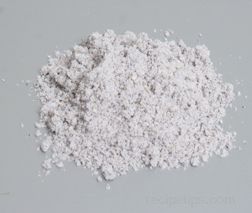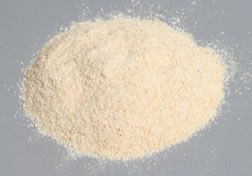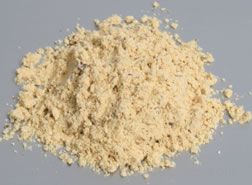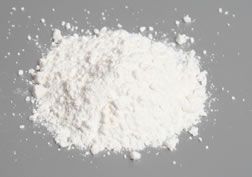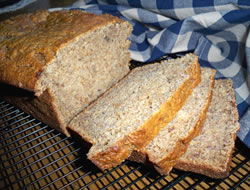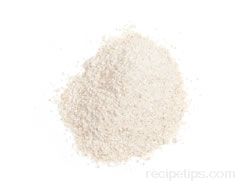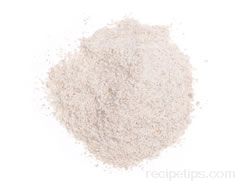|
Types of Flour Ground from Wheat One of the primary reasons for the popularity of wheat flour is due to its gluten forming capacity when the flour is mixed with liquid. Gluten is the substance that provides dough with elasticity and the ability to stretch as the leavening agent produces carbon dioxide gas, which enables the dough to rise effectively. The more protein in the wheat flour (as is the case with flour milled from hard wheat), the more gluten is formed when the flour is mixed with liquid. Various types of wheat are milled into a wide range of flours that are used for specific purposes:
| ||
|
All-Purpose Flour As the name suggests, all-purpose flour is suitable for most purposes and is perhaps the most commonly used wheat flour for general baking and cooking. It is produced from a combination of high protein bread flour and low protein cake flour. The bread flour is milled from a variety of hard wheat, which contains high levels of gluten. This is a necessary component for baked items to rise properly. The cake flour is milled from a variety of soft wheat, which is lighter, contains lower levels of gluten, and results in baked items that are tender and less dense. The combination of the flours gives the all-purpose flour just the right balance for most baked goods.
All-purpose wheat flour is available in bleached and unbleached varieties. Wheat flour becomes white (actually off-white) naturally through oxidation, which in earlier times was the method used by flour millers to create white flour. This eventually became impractical because of the time and space required for large quantities of flour to oxidize naturally so chemical bleaching was developed, which hastens the whitening process. The advantage of using bleached flour rather than unbleached is that the chemicals used for bleaching (usually chlorine, which evaporates after it is added to the flour) act as a preservative so that the flour will not develop an off flavor or spoil after a short period. The chemicals also prevent dough from becoming discolored and provide more consistent results when baking, however the chemicals affect the gluten strength of the flour, therefore bread makers often prefer unbleached flour. Unbleached all-purpose flour is often better for preparing several types of dough because the dough is easier to handle and the resulting baked goods are quite tender. All-purpose flour can be used for almost any recipe requiring flour such as breads, cakes, and pastries; as a coating for meat, vegetables, and other food items intended for frying or sautéing; and as a thickening agent for gravies, sauces, and stews. | ||
|
Bolted Flour Bolted flour is a type of whole-wheat flour in which nearly 80 percent of the bran has been removed. Bolted flour may also be referred to as reduced bran wheat flour. | ||
|
Bread Flour
| ||
|
Bromated Flour
| ||
|
Cake Flour
If cake flour is not available, cornstarch makes a good substitute. All-purpose flour can also be used although the results will not be quite as light and airy. Subtract 2 tablespoons from each cup specified in the recipe when using all-purpose flour as a substitute for cake flour. | ||
|
Chapati Flour Chapati flour is produced from whole wheat that has been ground to a very fine consistency. It is extremely popular in India and is used to prepare a number of Indian flatbreads including chapatis and rotis. | ||
|
Enriched Flour
Many types of commercially milled flours are enriched. The Food and Drug Administration mandates that every package of all-purpose flour be enriched due to the removal of the nutrient-rich bran and germ during the milling process. | ||
|
Farina Farina is a type of flour or meal made from almost any type of grain, nut, or starchy root, but is most often made from wheat. It is usually boiled in water to create a bland tasting hot breakfast cereal or it can be used as an ingredient in other dishes. Farina is produced with removal of the bran from hulled wheat grains and then grinding the grains into a fine powder. The endosperm and some of the germ are the components of the grain that remain. It is usually enriched with iron and B vitamins during processing due to the loss of most of the nutrient-rich germ and all of the bran. | ||
|
Gluten Flour
Gluten flour is most often used as an additive for various flours that are low in gluten or are gluten free, but it tends to toughen bread if used in excess. It is very useful for the preparation of pizza dough, bagels, and flat breads and rolls. It is often confused with bread flour, which is fortified with additional gluten, but has a lower gluten content than gluten flour. | ||
|
Graham Flour
Graham flour is often confused with standard whole-wheat, but there are some differences. In Graham flour, coarsely ground flakes of bran are added and the wheat germ is usually removed to lengthen the shelf life of the flour. Graham flour is most often used in the production of graham crackers. | ||
|
Instant Flour Instant flour is a type that dissolves easily in liquids that range from cold to hot in temperature. This type of flour is most often used when gravies, sauces, soups, and other food items require thickening. Instant flour is also known as granular flour. | ||
|
Organic Flour
| ||
|
Pastry Flour Pastry flour is produced from soft-wheat and it has a fine-texture and a high starch content. Pastry flour is finely ground, but it is not as fine as cake flour. It is available in bleached and unbleached varieties and is most often used for making flaky pie crusts, cookies, biscuits, and assorted pastries. It is not suitable for bread making because the gluten content is too low, but its gluten content is greater than that of cake flour. | ||
|
Self-Rising Flour
| ||
|
Semolina Flour
Semolina flour is available coarsely ground or ground twice for a fine texture. Besides pasta, semolina flour is occasionally used for gnocchi (an Italian dumpling), various breads, and a variety of other baked goods. Bread made with semolina flour has a crispy crust and a chewy interior. It is interesting to note that Italian pasta makers never refer to semolina as flour - they refer to it as grain. | ||
|
Tortilla Flour Tortilla flour is a type of wheat flour that is most often used for quick breads, such as muffins, biscuits, and dumplings, and flatbreads such as chapatis and tortillas. | ||
|
Whole-Wheat Flour
Fine grain whole-wheat flour is used for all types of baked goods, such as breads, rolls, and pastries. Medium grained can be used for the same types of foods, but will provide a coarser crumb. Coarse whole-wheat flour has a much larger bran particle and consequently is most often used to provide breads with natural, nutty flavors and rough textures. Whole-wheat flour used for bread making is usually milled from red wheat. White whole-wheat flour is milled from hard white winter wheat and has a milder flavor, lighter color, and a texture that is not as course. Whole-wheat flour used alone in bread making results in a nutritious, but smaller and denser loaf due to the bran, which hinders the dough from rising fully. In order to create a bread loaf that is a bit lighter and of greater volume, it is often best to combine whole-wheat flour with all-purpose flour or bread flour. Whole-wheat flour may also be referred to as entire wheat flour or graham flour (although there are some differences). | ||
|
Whole-Wheat Pastry Flour Like refined white pastry flour, whole-wheat pastry flour is produced from soft-wheat and it has a fine-texture and a high starch content, however not all of the bran and germ portions of the wheat kernel have been removed during the milling process. Because of the presence of some of the bran and germ, pastry items made with whole-wheat pastry flour are more nutritious than pastries made with white pastry flour, but they are not quite as light and airy. | ||
Loading
Types of Wheat Flour

Provided By
RecipeTips
RecipeTips

Loading
There currently aren't any reviews or comments for this article. Be the first!
Advertisement
Advertisement




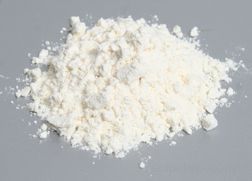
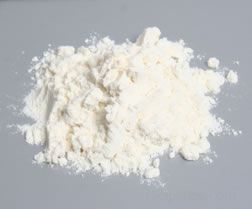 Bread flour is unbleached, high-gluten flour that typically contains 99.9 % hard wheat flour with malted barley added to increase the yeast activity, making it ideal for bread making. The high gluten content is necessary in order for bread to rise effectively. The use of bread flour results in larger bread loaves with a lighter and less crumbly texture. Bread flour is most often used in the commercial baking industry and is often confused with gluten flour, which has a higher gluten content than bread flour. Bread flour is also referred to as unbleached flour.
Bread flour is unbleached, high-gluten flour that typically contains 99.9 % hard wheat flour with malted barley added to increase the yeast activity, making it ideal for bread making. The high gluten content is necessary in order for bread to rise effectively. The use of bread flour results in larger bread loaves with a lighter and less crumbly texture. Bread flour is most often used in the commercial baking industry and is often confused with gluten flour, which has a higher gluten content than bread flour. Bread flour is also referred to as unbleached flour.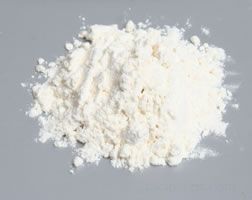 Bromides added to flour help to ensure consistent results in baked goods. The bromides help to strengthen the flour to achieve optimum gluten formation for bread making. Bromated flour is rarely used in the United States because ascorbic acid is now used to strengthen wheat flour that is specifically used for bread making.
Bromides added to flour help to ensure consistent results in baked goods. The bromides help to strengthen the flour to achieve optimum gluten formation for bread making. Bromated flour is rarely used in the United States because ascorbic acid is now used to strengthen wheat flour that is specifically used for bread making.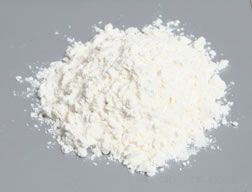 Cake flour is produced from the endosperm portion of the wheat kernel of soft wheat varieties. It is high in starch and has a low protein content, which means that it contains very little gluten, making it suitable for cake recipes.
Cake flour is produced from the endosperm portion of the wheat kernel of soft wheat varieties. It is high in starch and has a low protein content, which means that it contains very little gluten, making it suitable for cake recipes.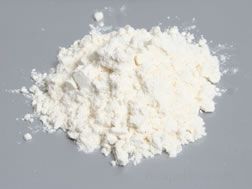 Enriched flours have been processed from grain to remove the bran and germ, bleached to whiten the appearance, and then reformulated with nutrients, such as thiamin, riboflavin, niacin, Vitamin D, iron, and calcium added in accordance with established government guidelines. It is necessary to add the nutrients because of the removal of the bran and germ, which contain most of the nutrients found in wheat grain. The main advantage in removing the oily germ is that flour keeps for much longer periods.
Enriched flours have been processed from grain to remove the bran and germ, bleached to whiten the appearance, and then reformulated with nutrients, such as thiamin, riboflavin, niacin, Vitamin D, iron, and calcium added in accordance with established government guidelines. It is necessary to add the nutrients because of the removal of the bran and germ, which contain most of the nutrients found in wheat grain. The main advantage in removing the oily germ is that flour keeps for much longer periods.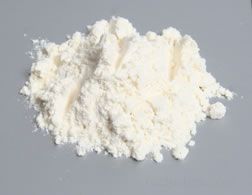 Gluten flour is produced from hard wheat that has been treated to remove the starch. It contains a greater percentage of gluten (at least 70% pure) than other types of flour and a lower percentage of starch. The gluten content of the flour has nearly twice the strength of regular wheat flour. Gluten is the protein that gives bread its elastic quality and aids in the rising process of the dough.
Gluten flour is produced from hard wheat that has been treated to remove the starch. It contains a greater percentage of gluten (at least 70% pure) than other types of flour and a lower percentage of starch. The gluten content of the flour has nearly twice the strength of regular wheat flour. Gluten is the protein that gives bread its elastic quality and aids in the rising process of the dough.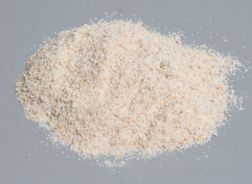 Graham flour is a type of wheat flour that is slightly coarser than regular flour. The Rev. Sylvester Graham, an early advocate of healthier foods, developed the flour. He was specifically interested in the beneficial uses of bran in the diet and believed that bread should not be made with highly processed flour, but with whole-grain flour.
Graham flour is a type of wheat flour that is slightly coarser than regular flour. The Rev. Sylvester Graham, an early advocate of healthier foods, developed the flour. He was specifically interested in the beneficial uses of bran in the diet and believed that bread should not be made with highly processed flour, but with whole-grain flour. Organic flour is milled from wheat that is grown and processed according to specific standards. Some of the standards include farming practices that prohibit the use of synthetic pest control and artificial fertilizers. Crop rotation is used to minimize the risk from diseases and pests. When the wheat is milled, it cannot be exposed to any other non-organic foods during processing. Specific rules on sanitation, storage, packaging, and labeling are also required. An independent agency must certify that the flour meets or exceeds the required organic standards and regular inspections are required of the growers and the processors.
Organic flour is milled from wheat that is grown and processed according to specific standards. Some of the standards include farming practices that prohibit the use of synthetic pest control and artificial fertilizers. Crop rotation is used to minimize the risk from diseases and pests. When the wheat is milled, it cannot be exposed to any other non-organic foods during processing. Specific rules on sanitation, storage, packaging, and labeling are also required. An independent agency must certify that the flour meets or exceeds the required organic standards and regular inspections are required of the growers and the processors.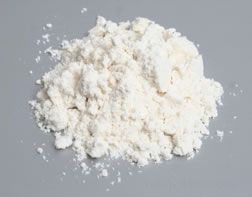 Self-rising flour is wheat flour in which the leavening agent has already been added. The leavening agent is generally in the form of baking powder. Salt is also commonly added to the mixture, so the sodium content is much higher than other types of flour. Self-rising flour is most often included in commercially prepared packaged mixes, such as cake mixes, and was developed as a means of saving time for the home cook. It is very popular in the southern United States where it is used more frequently than in northern states. Self-rising flour should not be used in preparing yeast breads and it is also worth noting that the leavening agent tends to lose its effectiveness the longer the flour is stored.
Self-rising flour is wheat flour in which the leavening agent has already been added. The leavening agent is generally in the form of baking powder. Salt is also commonly added to the mixture, so the sodium content is much higher than other types of flour. Self-rising flour is most often included in commercially prepared packaged mixes, such as cake mixes, and was developed as a means of saving time for the home cook. It is very popular in the southern United States where it is used more frequently than in northern states. Self-rising flour should not be used in preparing yeast breads and it is also worth noting that the leavening agent tends to lose its effectiveness the longer the flour is stored. Semolina is a granular flour with a light yellow color. It is produced from durum wheat, which is used almost exclusively for making pasta. Durum wheat has the ideal properties for making the best pasta. It is high in protein and gluten, which are necessary components for pasta making.
Semolina is a granular flour with a light yellow color. It is produced from durum wheat, which is used almost exclusively for making pasta. Durum wheat has the ideal properties for making the best pasta. It is high in protein and gluten, which are necessary components for pasta making.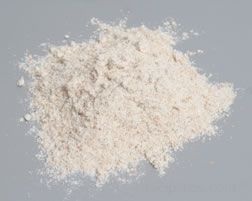 Whole-wheat flour is produced from grinding the full wheat berry (kernel). All parts of the wheat berry are used in the flour including the bran, germ, and the endosperm, which when milled, creates the speckled brown color that is characteristic of the flour. Three granulations (particle size) of whole-wheat are produced: fine, medium, and coarse. The particle size influences the rate liquid is absorbed into the flour. Finer grained flour absorbs liquid at a faster rate than medium or coarse grains, thus affecting the preparation of the dough.
Whole-wheat flour is produced from grinding the full wheat berry (kernel). All parts of the wheat berry are used in the flour including the bran, germ, and the endosperm, which when milled, creates the speckled brown color that is characteristic of the flour. Three granulations (particle size) of whole-wheat are produced: fine, medium, and coarse. The particle size influences the rate liquid is absorbed into the flour. Finer grained flour absorbs liquid at a faster rate than medium or coarse grains, thus affecting the preparation of the dough.